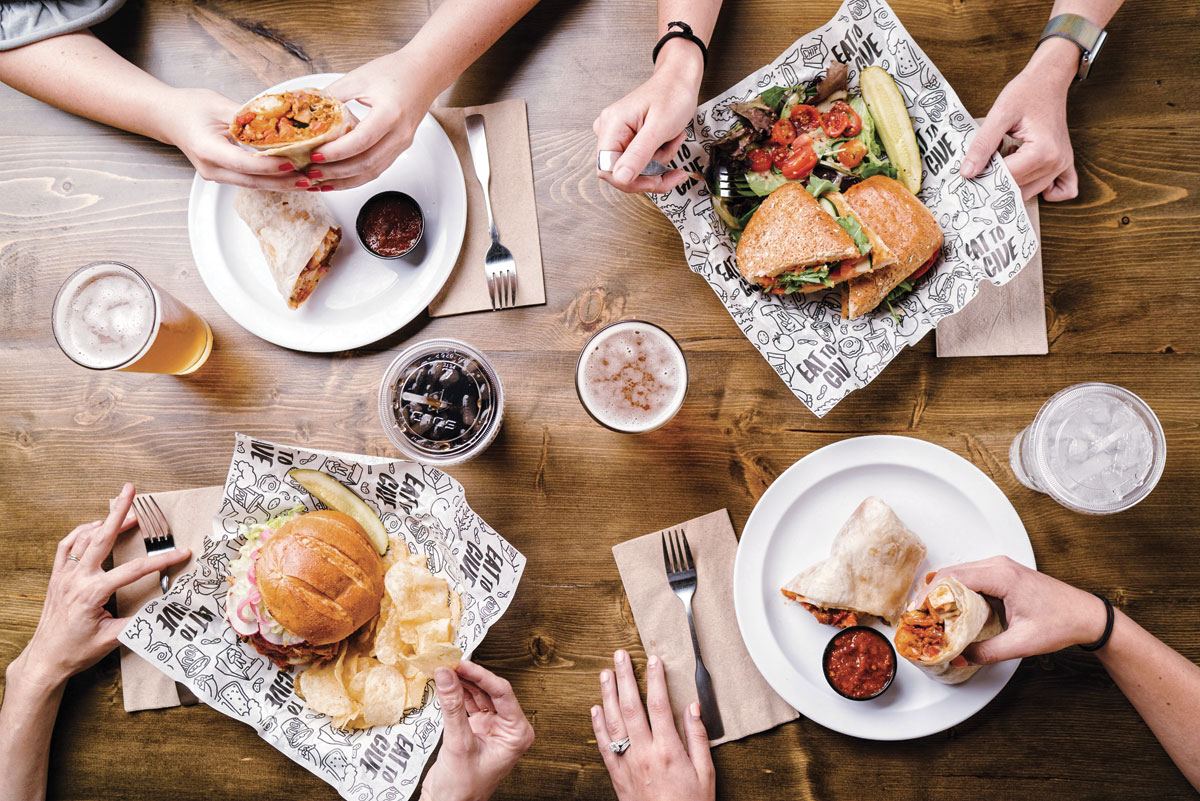FOUNDER: Steve Down
PRESIDENT: Michael McHenry
HEADQUARTERS: Salt Lake City
YEAR STARTED: 2014
ANNUAL SALES: $26 million (projected for 2018)
TOTAL UNITS: 20
FRANCHISE UNITS: 0
“Sandwich for sandwich” is Even Stevens’ motto. No, the Utah-based fast casual wasn’t titled after the 2000s Disney Channel show of the same name. It was instead named by entrepreneur and founder Steve Down and based on the restaurant’s “eat to give” philanthropic mission.
“For every sandwich sold in our shops, we donate a sandwich to a local nonprofit partner in the neighborhood where we are doing business,” says Michael McHenry, president of Even Stevens. Each of the chain’s 20 company-owned locations partners with four nonprofits that are fighting hunger in some way within the restaurant’s local community. Nonprofits include the Boys & Girls Clubs of America, Native American Connections in Phoenix, and Bienvenidos Food Bank in Denver.
The brand opened its first shop in downtown Salt Lake City in 2014, but the team—Down, McHenry, culinary director Brandon Price, and cause director Sara Day—had almost a full year to strategize. They crafted the menu, defined the company culture, and built out its nonprofit program.
“From the very start, we knew we wanted to grow and expand across the country, yet still maintain a local community feel in each neighborhood where we put an Even Stevens,” McHenry says.
For its target market of socially conscious millennials, Even Stevens serves a menu of craft sandwiches, salads, shareable bites, and breakfast items made mostly from neighborhood-sourced products.
One all-time guest favorite is the Pot Roast Dip, which includes turkey pot roast, Swiss cheese, and jalapeño jelly, all on a house-baked baguette with a side of au jus. Another menu darling is the vegan Jackfruit Torta, which brings together jackfruit (a relative to figs and breadfruit) made into carnitas, pumpkin seeds, avocado, and other toppings on a sweet bun. McHenry says it’s important that Even Stevens’ vegan dishes aren’t simply veggies haphazardly paired, but rather dishes that customers crave.
“We treat every menu item like a conversation,” McHenry says. “Most people don’t know that the banh mi is both French and Vietnamese, or that one out of 10 shishito peppers is a spicy rascal. There’s something infinitely more satisfying about a meal that’s served up with a story than a mouthful of supply-chain predictables.”
Another key to Even Stevens’ success, McHenry says, is its approach to hiring team members, which the company calls experience creators. The brand doesn’t screen for career cooks and servers, but rather seeks individuals who are committed to making a positive, sustained impact in their neighborhoods. “Then we teach them how to put two slices of bread together,” McHenry says. The brand’s culinary and training departments, he adds, allow the company to achieve this in a scalable fashion.
Another way Even Stevens stores stay vested in their surroundings is by working with neighborhood furniture makers and artists to create a unique space. Furniture is repurposed from local sources like old bowling alleys, while artists handpaint signage and take on custom projects for the walls.
“Even Stevens spaces are fluid and flexible, allowing for customers to enjoy a casual dining experience quickly or at a laidback pace in one of the many eclectic lounge spaces filled with board games, books, and found objects,” McHenry says. “No two Even Stevens are the same.”
Knowing Even Stevens’ model—high-quality food meets a buy-one-give-one philosophy—it raises the question of solvency. The company allocates 5–6 percent of its budget, which would otherwise be spent on advertising campaigns such as direct mail, billboards, and TV and radio advertisements, to its community engagement through philanthropy. “Basically, it’s artful word-of-mouth around our shops,” McHenry says.
In its one-for-one initiative, Even Stevens sets each partner up with a Sysco account, through which the nonprofits can order the sandwich-making ingredients—meat, bread, produce, etc.—and use those items to make meals or stock pantries. Structuring the program this way helps Even Stevens reduce food waste and be more efficient since the locations aren’t making and delivering each sandwich. As of this February, Even Stevens had donated the ingredients for 2,412,189 sandwiches to its various nonprofit partners.
“When people first hear about our concept, they typically think that we just work with organizations that are helping those facing homelessness,” McHenry says. “While this is a large share of the groups we help, our partners also include senior centers, domestic violence shelters, youth programs, addiction recovery, rescue missions, etc.”
Currently in Utah, Arizona, Colorado, Idaho, Texas, and Washington, the concept is set to enter California and Oregon this year with 15 more locations in the works.
And by the end of 2020, McHenry envisions 100 thriving Even Stevens locations, each maintaining the brand’s commitment to the communities it serves. “Not only do I believe we are going to achieve this, but, as one of the industry’s fastest-growing and most innovative brands, we are on pace to surpass this lofty goal,” McHenry says.










